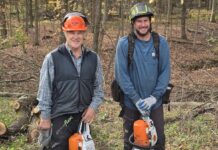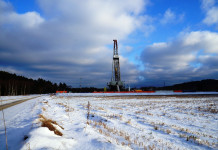
UNITY TOWNSHIP, Ohio — Jan Douglass vividly remembers the day of her epiphany. It was in May 2019. Hard, fast rains had been pounding her farm for days in a row. The land had been farmed in a traditional corn and soybean rotation with no cover crops. The ground was bare at the time.
“I walked out one day, and I had 2 foot gullies in the field,” she said. “I couldn’t even begin to fathom how much topsoil I had lost … I sobbed.”
She remembers looking skyward and apologizing to God for letting this happen. Then, she got to work figuring out how to fix the problem. That’s when she learned about regenerative agriculture.
It was that day that eventually brought together Douglass with Bob Black, the farmer who leases her ground; Fred Kungl, a drone operator; and Sarah Eichler, a professor at Kent State University. The group met Oct. 11 at Douglass’s Paradise Acres Farm, in Unity Township, to witness the launch of Douglass’s latest experiment.
She hired Kungl to use his drone to broadcast seed cereal rye into about 30-40 acres of Black’s standing corn. The cereal rye is intended to be used as a cover crop. Black will also plant rye after he takes corn off in a few weeks.
The experiment
The goal is to see how well each method works to get a cover crop growing before the winter freeze hits. Eichler will take samples from the fields before the corn is harvested and afterward, to see the germination rate of the cover crop.
Eichler, an assistant professor of biological sciences at Kent State-Salem, met Douglass while doing work for another research project. Douglass’s farm is one of several sites being used to look at different ways to measure soil health, including in-field and remote measurements. On that project, Eichler is working with Joseph Ortiz, with Kent State’s Department of Earth Sciences, and Ohio State University’s Rattan Lal.
Eichler said the rye seed that was broadcast into standing corn may not germinate as well as rye that’s seeded later on bare ground. Fields seeded by drone , however, will have longer to grow. That could make a significant difference in the amount of biomass on the ground through the winter.
Fred Kungl, of FK Agronomics, based in Amsterdam, Ohio, operated the drone. Kungl bought the drone to use on his farm. When he figured out it would be just as much paperwork to use the drone on his farm as it was to operate it commercially, he began contracting out his services.
The drone, an Agras T30, can hold about 70 pounds of seed. Before launching the drone, Kungl mapped out the field on the drone’s controller to set the pattern the machine would fly.
The six-rotor machine made short flights, broadcasting seed at a rate of 50 pounds per acre. Each flight took about five minutes. The drone flew back to the point where it launched when it was empty.
With the favorable flying conditions, the drone could get two flights per battery. Kungl had a generator on his trailer charging batteries. It took over two hours to seed about 30-40 acres.

The change
Douglass didn’t think much about the farm’s land until that day in 2019 after the rains. They’d had the same farmer lease their ground for more than a decade. Her husband, Gene, handled all that stuff, she said. After he died in 2012, she kept signing the lease agreement because that’s what was easiest.
Douglass found a new farmer to lease her land, one who was willing to try some of the things she was interested in, after the previous farmer’s contract was up. Bob Black, of Rogers, Ohio, took over leasing Douglass’s land last year.
Douglass said they make all decisions together about how the land is managed. They talk a lot about new ideas she has from books she’s read or research she’s done online. Black keeps her grounded with his knowledge of farming and the land. It’s a unique arrangement for a lessor and lessee.
“You have a right to say how your land is farmed,” she said.
That’s how they came to the drone seeding project. Douglass watched a video posted in an agricultural group on Facebook of someone doing drone seeding. She connected with the person who posted the video, who pointed her to a drone operator in eastern Ohio. The whole thing came to life in just a few weeks.
Black farms conventionally, too, although he has used cover crops more and more recently. He tends to be more skeptical than his landlord, but he’s willing to give things a try. Particularly, he wants to see how using regenerative farming practices can be profitably expanded to larger acreage production.
“You’re never going to move forward if you don’t do something,” he said.
The field was seeded with a cover crop of crimson clover last winter. In another experiment at Douglass’s request, Black terminated the cover crop on half the field using a turbo tiller. On the other half he used an herbicide. Douglass said that was the only weed suppression method used this year.
Douglass, Black and the research team want to know how these different practices are impacting soil health and profit margins, as well as the nutrient density in the crops themselves. That last measure is just for her.
“I want to know the crops coming off of my land are the best for human or animal consumption,” she said.
(Reporter Rachel Wagoner can be reached at 724-201-1544 or rachel@farmanddairy.com)









